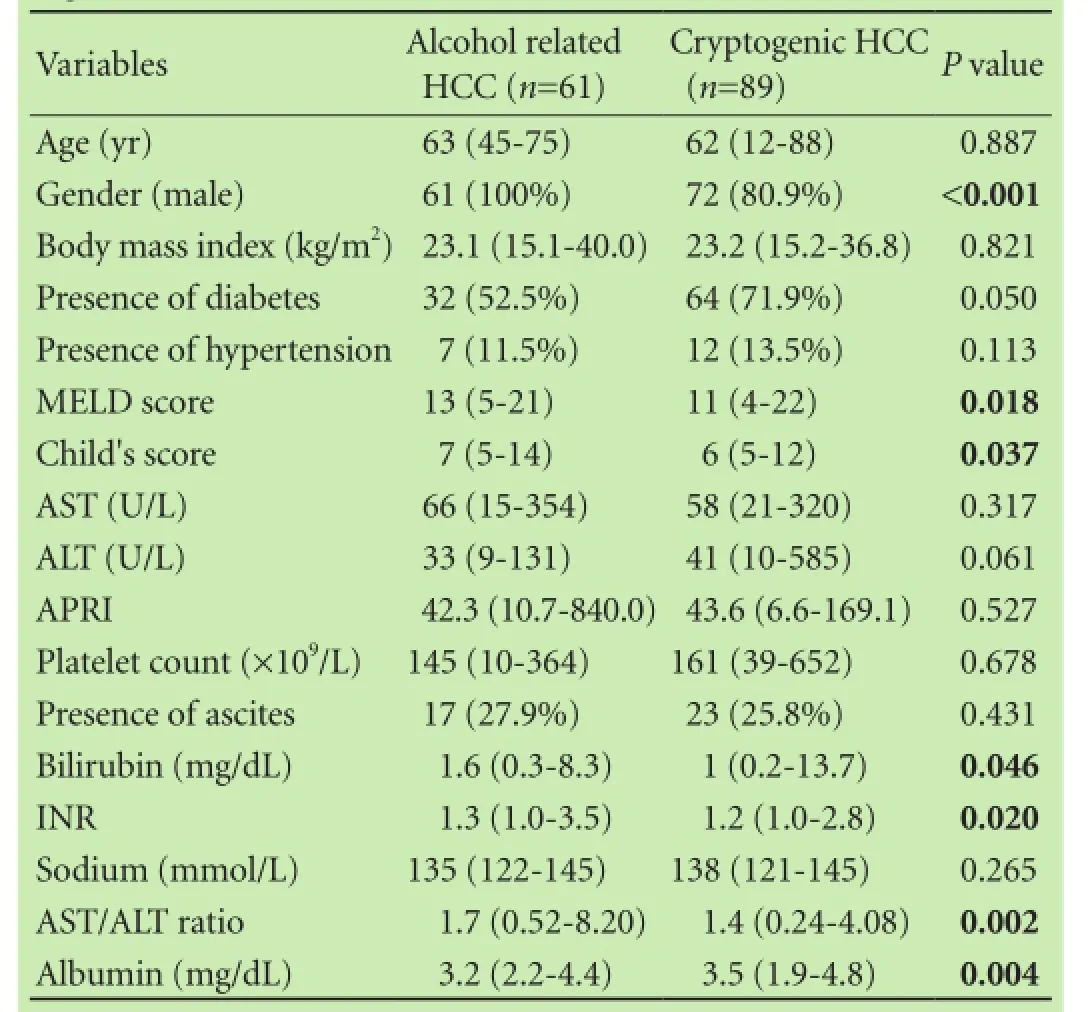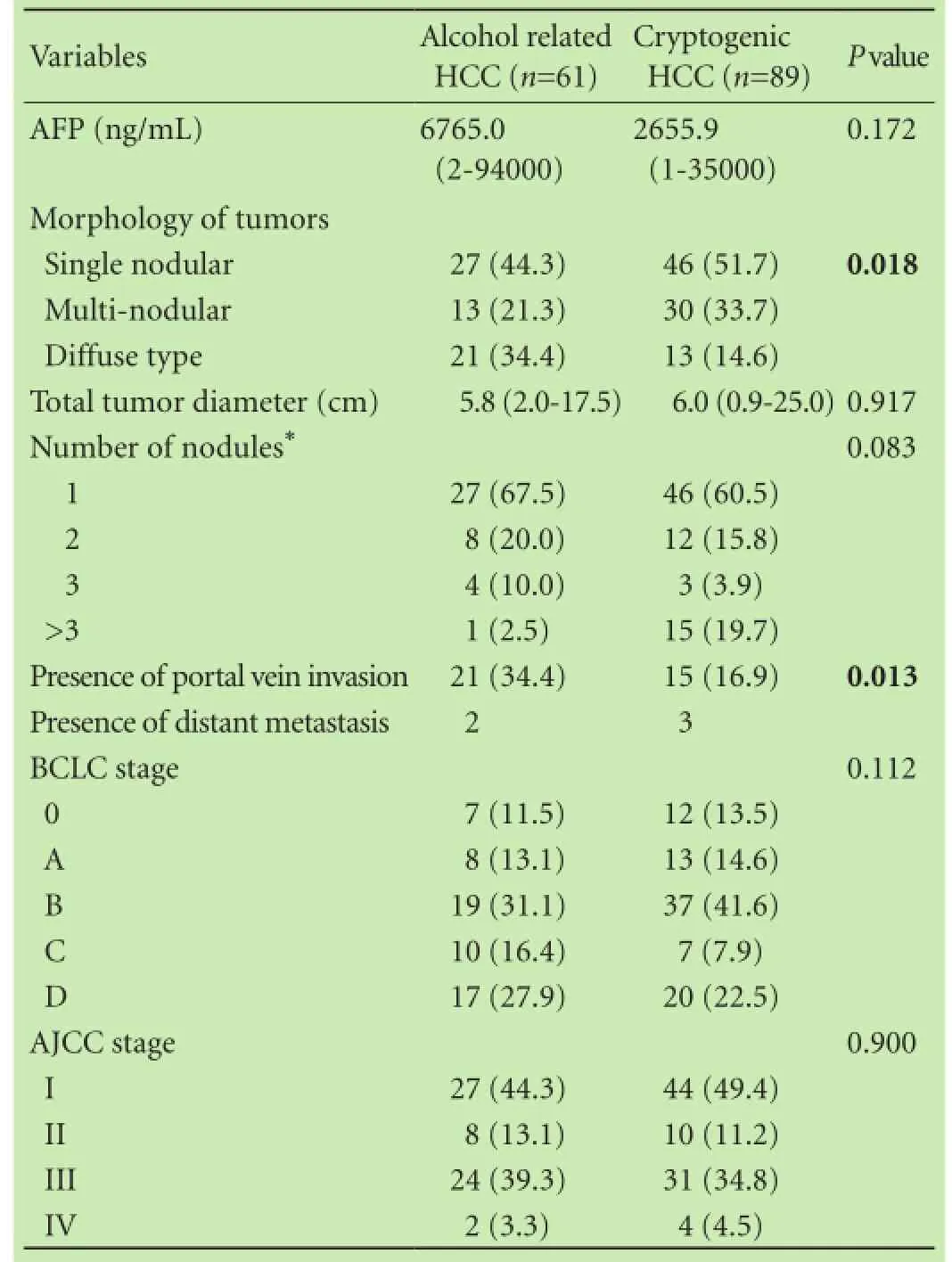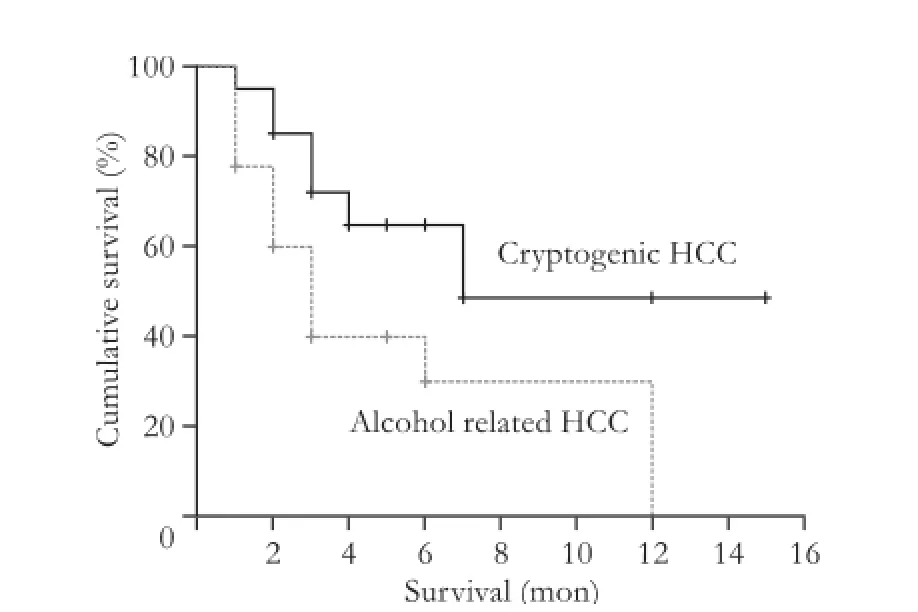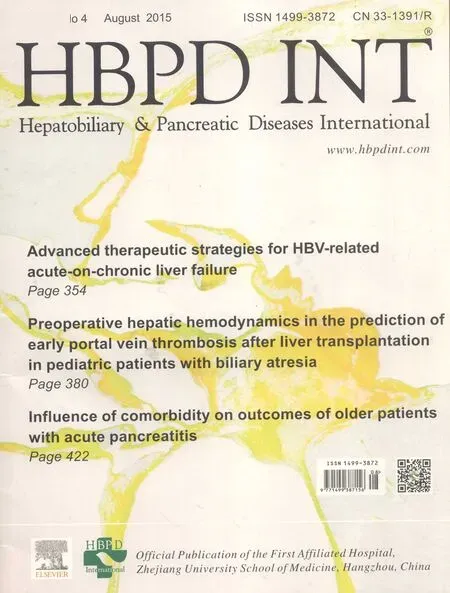Clinical characteristics and outcome of hepatocellular carcinoma in alcohol related and cryptogenic cirrhosis: a prospective study
Ragama, Sri Lanka
Clinical characteristics and outcome of hepatocellular carcinoma in alcohol related and cryptogenic cirrhosis: a prospective study
Rohan C Siriwardana, Maduni A Niriella, Anuradha S Dassanayake, Chandika Liyanage, Bhagya Gunathilaka, Subani Jayathunge and Hithanadura J de Silva
Ragama, Sri Lanka
BACKGROUND: Non-alcoholic fatty liver disease (NAFLD) is becoming a leading cause of chronic liver disease. Hepatocellular carcinoma (HCC) is one of its complications. Although the pathophysiology is unclear, it is reasonable to expect that cryptogenic cirrhosis related HCC (cryptogenic HCC) behaves differently to other types of HCC. This study prospectively compared patients with cryptogenic HCC and those with HCC related to alcoholic cirrhosis.
METHODS: A total of 150 consecutive patients with HCC (89 cryptogenic HCC and 61 alcohol related HCC) referred to our unit over a 23-month period were studied. Their demographic data, liver function, tumor characteristics and outcomes were compared.
RESULTS: Alcohol related HCC was seen only in males. Compared with cryptogenic HCC, alcohol related HCC had signifcantly higher aspartate aminotransferase/alanine aminotransferase (AST/ALT) ratio (1.7 vs 1.4, P=0.002), model for endstage liver disease score (13 vs 11, P=0.018) and Child's score (7 vs 6, P=0.037). No signifcant difference was seen in platelet counts, serum sodium and AST to platelet ratio index. Single nodular tumors were more common in cryptogenic HCC, while diffuse type tumors and macroscopic vascular invasion were common in alcohol related HCC. In patients who could not be offered any treatment because of advanced tumors or poor liver function, alcohol related HCC had a signifcantly lower median survival (5.3 months) compared with cryptogenic HCC (9.3 months, P=0.034).
CONCLUSIONS: Compared with cryptogenic HCC, alcohol related HCC had worse liver function and aggressive tumor morphology at presentation, and a higher proportion was untreatable. In patients who could not be treated, median survival was lower in patients with alcohol related HCC than in those with cryptogenic HCC.
(Hepatobiliary Pancreat Dis Int 2015;14:401-405)
hepatocellular carcinoma;
liver diseases;
alcoholic;
fatty liver
Introduction
Hepatitis B and C are the leading causes of hepatocellular carcinoma (HCC) worldwide.[1]Viral hepatitis leads to HCC as a complication of cirrhosis or as a result of direct integration of viral DNA into the host genome.[1]Alcohol is another leading cause of cirrhosis and HCC, and although the exact mechanism is not understood, chromosomal loss, oxidative stress, decreased retinoic acid levels in the liver, altered DNA methylation and genetic susceptibility may play a role.[2]Non-alcoholic fatty liver disease (NAFLD) and non-alcoholic steatohepatitis (NASH) are becoming increasingly prevalent in the Asian continent and are already a leading cause of chronic liver disease in the region.[3-5]NASH is now believed to account for most cases of cryptogenic cirrhosis worldwide.[6]Unlike in alcoholic liver disease, HCC can complicate NASH even in the absence of cirrhosis.[7,8]Although, here too, the pathophysiology is unclear, it is reasonable to expect that NASH related HCC behaves differently to alcohol and hepatitis related HCC.
In Sri Lanka the most common causes of cirrhosis are alcohol related and cryptogenic (probably NASH-re-lated). Hepatitis B, C and hemachromatosis are uncommon.[9]The present study compares tumor morphology, clinical characteristics and outcomes of patients with alcohol related HCC and cryptogenic cirrhosis related HCC (cryptogenic HCC).
Methods
One hundred and ffty consecutive patients with alcohol related and cryptogenic HCC referred to our clinic from January 2011 to December 2012 were included in the study. All data were collected prospectively. HCC was diagnosed according to the American Association for the Study of Liver Diseases (AASLD) guidelines.[10]Biopsy from the lesion was done in only 4 patients with atypical imaging. A detailed history was taken to assess the degree of alcohol consumption. Patients who had a history of consuming alcohol above the accepted safe limits (Asian standards: <14 units of alcohol per week in men and<7 units per week in women) prior to the diagnosis of cirrhosis were considered as having alcoholic cirrhosis. There were 61 patients in the alcohol related HCC group, and their median abstinence from alcohol on presentation to our unit was 7 months. Patients who did not drink alcohol above the safe limits had no history of contributory drug or herbal product use and did not have hepatitis B and C, autoimmune disease, hemachromatosis, Wilson's disease, and alpha-1 antitrypsin defciency were considered to have cryptogenic HCC. However a liver biopsy had not been performed for the diagnosis of cryptogenic cirrhosis. There were 89 patients in the cryptogenic HCC group.
All patients underwent liver function assessment. Upper gastrointestinal endoscopy was done in all newly diagnosed cirrhotics. The presence of portal vein invasion was diagnosed when an enhancing tumor extension was detected in the main or sectoral portal vein branch. All these patients underwent portal vein Doppler to assess the fow within the thrombus. Management decisions were taken at a multi-disciplinary meeting. Decisions regarding liver transplantation, surgical resection, ablation, trans-arterial chemoembolization or sorafenib therapy were made according to tumor morphology, background liver status and functional index. Patients were followed up in a special combined medical and surgical clinic.
The majority of our patients with treatable disease underwent combined treatment. As the follow-up period was relatively short and multiple treatment combinations were used, the actual numbers treated with each combination was small. We therefore selected patients with Barcelona clinic liver cancer (BCLC) stages C and D who could not be given any active treatment, and compared survival in these patients (alcohol related versus cryptogenic).
Values of continuous variables were presented as median and range. Differences between the two groups were compared by the Chi-square test, Fisher's exact test or the Mann-Whitney U test where appropriate. Cumulative survival and recurrence rates were calculated using the Kaplan-Meier method and the difference between survivals was evaluated using the log-rank test. A P value of less than 0.05 was considered statistically signifcant.
Results
Of the 150 patients with HCC, 61 were alcohol related and 89 were cryptogenic originated. Alcohol related HCC was seen only in males. The two groups were not different in age or body mass index at presentation. Baseline liver functions were different in the two groups (Table 1). Alcohol related HCC had a signifcantly higher aspartate aminotransferase/alanine aminotransferase (AST/ALT) ratio (1.7 vs 1.4, P=0.002), a MELD score (13 vs 11, P=0.018), and a Child's score (7 vs 6, P=0.037). There was no signifcant difference in platelet count, serum sodium levels or AST to platelet ratio index (APRI) between the two groups. When tumor characteristics were compared, there was no difference in median tumor diameter or alpha-fetoprotein levels between the twogroups (Table 2). However, morphology of the tumors was different. Single nodular tumors were more common in the cryptogenic HCC while diffuse type tumors were more common in the alcohol related group. The presence of macroscopic vascular invasion was also more common in patients with alcohol related HCC. In nodular type tumors, the number of nodules was not signifcantly different in the two groups.

Table 1. Comparison of liver status in alcohol related and cryptogenic HCC

Table 2. Comparison of tumor morphology in alcohol related and cryptogenic HCC (n, %)
The most common initial treatment modality was transarterial chemoembolization which was performed in 33% of the patients in each group (29 patients with cryptogenic HCC and 20 with alcohol related HCC). Surgery was performed for 26% (n=23) of the patients with cryptogenic HCC and 10% (n=6) of the patients with alcohol related HCC. Percutaneous ablation was performed for 11% (n=10) of the patients with cryptogenic HCC and 15% (n=9) of the patients with alcohol related HCC. About 43% (n=26) of the patients in the alcohol related HCC group were not candidates for any active intervention compared to 30% (n=27) of those in the cryptogenic HCC group. The median follow-up was 12 months. As the treatments were heterogeneous and different combinations were used, a sub-analysis was made to compare survival of those patients who could not be given any treatment due to advanced tumors or poor liver function. In this sub-analysis, alcohol related HCC had a signifcantly lower median survival (5.3 months) compared with cryptogenic HCC (9.3 months, P=0.034) (Fig.).

Fig. Survival of patients who did not have any treatment (P=0.034).
Discussion
At presentation, patients with alcohol related HCC had worse liver function and more aggressive tumors (diffuse type and with macroscopic vascular invasion) compared with those with cryptogenic HCC. In all patients who could not be treated because of advanced tumors or poor liver function, the median survival was lower in patients with alcohol related HCC than in those with cryptogenic HCC.
Few studies have investigated the clinical characteristics and outcome of cryptogenic HCC or compared this with other types of HCC. One study[11]evaluated the radiological characteristics of NAFLD related HCC; like in our study, tumors were solitary and of a predominantly nodular type. A study comparing alcohol related HCC with hepatitis B, C and NAFLD related HCC revealed that although background liver function in the two groups was comparable, the alcohol related HCC group had more multi-nodular tumors.[12]However, Hashimoto et al[13]compared 56 patients with alcohol related HCC and 8 patients with NAFLD related HCC, and did not fnd any differences in tumor morphology. Our cohort was relatively larger and showed clear differences in both background liver function status and tumor aggressiveness.
With the differences we found, we proposed a new theory that the cryptogenic HCC is a distinct entity. This was suggested by Salomao et al[14]who compared histological features of NAFLD related HCC with those of HCV related HCC. NAFLD related HCC had distinct histological features with large droplet steatosis, bal-looning of malignant hepatocytes, Mallory-Denk bodies, and pericellular fbrosis. Alternative mechanisms have now been suggested for NAFLD related carcinogenesis. Lipid droplet-associated proteins (perilipin, adipophilin and perilipin 3) are differentially expressed in hepatic steatogenesis. Adipophilin is up-regulated in the early tumorigenesis and perilipin is often lost.[15]Thus, available basic science data also suggest that cryptogenic HCC is a distinct entity with good prognostic tumor characteristics.[14,15]
In previously reported data, the frequency of diffuse type HCC varied from 7% to 13% of all the HCC cases.[16]A similar frequency was seen in our patients with cryptogenic HCC. However, the frequency is almost double this in alcohol related HCC. This difference in tumor morphology may play a role in the higher frequency of macroscopic vascular invasion and poor median survival among patients who could not be given any treatment. Previous data on diffuse infltrative HCC are limited. Alcohol as a risk factor for diffuse type HCC has also not been previously investigated. However, data from Kubo et al[17]and Okada et al[18]showed that alcohol in synergy with another risk factor such as hepatitis B or C affects the malignancy of the tumor and worsens the prognosis of the patients. Okada et al[18]attributed the poor prognosis to higher tumor proliferative activity in these patients. Alcohol is also a signifcant risk factor for the development of HCC in patients with NAFLD.[19]In Sri Lanka, about 33% of urban adults have NAFLD.[5]Thus, a considerable proportion of our patients with alcohol related HCC may have had NAFLD as an additional risk factor. Whether this combination can lead to more aggressive HCC needs further investigation. Reddy et al[20]compared the outcome of surgical resection in NAFLD related HCC and HCV related HCC. The NAFLD group had better overall survival, and this was attributed to better preserve liver function. The groups did not show a difference in tumor morphology. However, these were highly selected patients who were candidates suitable for surgical resection, and this may be the reason that the tumor morphology was similar. When we sub-analyzed the survival of patients who could not be given any treatment, the results also suggested a better survival outcome for patients with cryptogenic HCC. Diffuse type tumor and macroscopic vascular invasion may at least partly explain the different outcome.
In conclusion, clinical, morphological and limited basic science data suggest that cryptogenic HCC may behave differently to other types of HCC. Given the rising incidence of NAFLD worldwide, HCC related to this condition needs further comprehensive study. research and wrote the frst draft. LC, GB and JS collected and analyzed the data. NMA revised the manuscript. All authors contributed to the design and interpretation of the study and to further drafts. SRC is the guarantor.
Funding:None.
Ethical approval:This study was approved by the Ethical Review Committee, Faculty of Medicine, University of Kelaniya.
Competing interest:No benefts in any form have been received or will be received from a commercial party related directly or indirectly to the subject of this article.
Contributors:SRC proposed the study. DAS and SHJ performed
1 Blum HE, Moradpour D. Viral pathogenesis of hepatocellular carcinoma. J Gastroenterol Hepatol 2002;17:S413-420.
2 Morgan TR, Mandayam S, Jamal MM. Alcohol and hepatocellular carcinoma. Gastroenterology 2004;127:S87-96.
3 Chitturi S, Farrell GC, George J. Non-alcoholic steatohepatitis in the Asia-Pacifc region: future shock? J Gastroenterol Hepatol 2004;19:368-374.
4 Siriwardana RC, Niriella MA, Liyanage CA, Wijesuriya SR, Gunathilaka B, Dassanayake AS, et al. Cryptogenic cirrhosis is the leading cause for listing for liver transplantation in Sri Lanka. Indian J Gastroenterol 2013;32:397-399.
5 Dassanayake AS, Kasturiratne A, Rajindrajith S, Kalubowila U, Chakrawarthi S, De Silva AP, et al. Prevalence and risk factors for non-alcoholic fatty liver disease among adults in an urban Sri Lankan population. J Gastroenterol Hepatol 2009;24: 1284-1288.
6 Powell EE, Cooksley WG, Hanson R, Searle J, Halliday JW, Powell LW. The natural history of nonalcoholic steatohepatitis: a follow-up study of forty-two patients for up to 21 years. Hepatology 1990;11:74-80.
7 Rosmorduc O, Fartoux L. HCC and NASH: how strong is the clinical demonstration? Clin Res Hepatol Gastroenterol 2012;36:202-208.
8 Page JM, Harrison SA. NASH and HCC. Clin Liver Dis 2009;13: 631-647.
9 Senanayake SM, Niriella MA, Weerasinghe SK, Kasturiratne A, de Alwis JP, de Silva AP, et al. Survival of patients with alcoholic and cryptogenic cirrhosis without liver transplantation: a single center retrospective study. BMC Res Notes 2012;5:663.
10 Bruix J, Sherman M; American Association for the Study of Liver Diseases. Management of hepatocellular carcinoma: an update. Hepatology 2011;53:1020-1022.
11 Iannaccone R, Piacentini F, Murakami T, Paradis V, Belghiti J, Hori M, et al. Hepatocellular carcinoma in patients with nonalcoholic fatty liver disease: helical CT and MR imaging fndings with clinical-pathologic comparison. Radiology 2007;243: 422-430.
12 Lee SS, Jeong SH, Byoun YS, Chung SM, Seong MH, Sohn HR, et al. Clinical features and outcome of cryptogenic hepatocellular carcinoma compared to those of viral and alcoholic hepatocellular carcinoma. BMC Cancer 2013;13:335.
13 Hashimoto E, Taniai M, Kaneda H, Tokushige K, Hasegawa K, Okuda H, et al. Comparison of hepatocellular carcinoma patients with alcoholic liver disease and nonalcoholic steatohepatitis. Alcohol Clin Exp Res 2004;28:164S-168S.
14 Salomao M, Yu WM, Brown RS Jr, Emond JC, Lefkowitch JH. Steatohepatitic hepatocellular carcinoma (SH-HCC): a distinc-tive histological variant of HCC in hepatitis C virus-related cirrhosis with associated NAFLD/NASH. Am J Surg Pathol 2010;34:1630-1636.
15 Straub BK, Herpel E, Singer S, Zimbelmann R, Breuhahn K, Macher-Goeppinger S, et al. Lipid droplet-associated PAT-proteins show frequent and differential expression in neoplastic steatogenesis. Mod Pathol 2010;23:480-492.
16 Trevisani F, Caraceni P, Bernardi M, D'Intino PE, Arienti V, Amorati P, et al. Gross pathologic types of hepatocellular carcinoma in Italian patients. Relationship with demographic, environmental, and clinical factors. Cancer 1993;72:1557-1563.
17 Kubo S, Kinoshita H, Hirohashi K, Tanaka H, Tsukamoto T, Shuto T, et al. High malignancy of hepatocellular carcinoma in alcoholic patients with hepatitis C virus. Surgery 1997;121: 425-429.
18 Okada S, Ishii H, Nose H, Okusaka T, Kyogoku A, Yoshimori M, et al. Effect of heavy alcohol intake on long-term results after curative resection of hepatitis C virus-related hepatocellular carcinoma. Jpn J Cancer Res 1996;87:867-873.
19 Ascha MS, Hanouneh IA, Lopez R, Tamimi TA, Feldstein AF, Zein NN. The incidence and risk factors of hepatocellular carcinoma in patients with nonalcoholic steatohepatitis. Hepatology 2010;51:1972-1978.
20 Reddy SK, Steel JL, Chen HW, DeMateo DJ, Cardinal J, Behari J, et al. Outcomes of curative treatment for hepatocellular cancer in nonalcoholic steatohepatitis versus hepatitis C and alcoholic liver disease. Hepatology 2012;55:1809-1819.
Received February 27, 2014
Accepted after revision September 1, 2014
It is at our mother's knee that we acquire our noblest and truest and highest, but there is seldom any money in them.—Mark Twain
Author Affliations: Department of Surgery (Siriwardana RC, Liyanage C and Jayathunge S), Department of Medicine (Niriella MA, Gunathilaka B and de Silva HJ) and Department of Pharmacology (Dassanayake AS), Faculty of Medicine, University of Kelaniya, Ragama, Sri Lanka
Rohan C Siriwardana, MD, Department of Surgery, Faculty of Medicine, University of Kelaniya, Ragama, Sri Lanka (Tel: +94-777-250213; Email: rohansiriwardana@yahoo.com)
? 2015, Hepatobiliary Pancreat Dis Int. All rights reserved.
10.1016/S1499-3872(15)60343-5
Published online January 19, 2015.
 Hepatobiliary & Pancreatic Diseases International2015年4期
Hepatobiliary & Pancreatic Diseases International2015年4期
- Hepatobiliary & Pancreatic Diseases International的其它文章
- Pancreaticoduodenectomy with portal vein/superior mesenteric vein resection for patients with pancreatic cancer with venous invasion
- The response of Golgi protein 73 to transcatheter arterial chemoembolization in patients with hepatocellular carcinoma may relate to the influence of certain chemotherapeutics
- A serum metabolomic analysis for diagnosis and biomarker discovery of primary biliary cirrhosis and autoimmune hepatitis
- Influence of comorbidity on outcomes of older patients with acute pancreatitis based on a national administrative database
- Development and validation of a predictive score for perioperative transfusion in patients with hepatocellular carcinoma undergoing liver resection
- Impact of venous thromboembolism on the natural history of pancreatic adenocarcinoma
